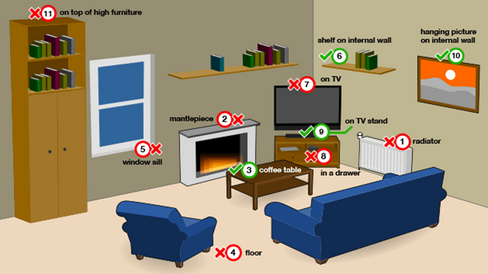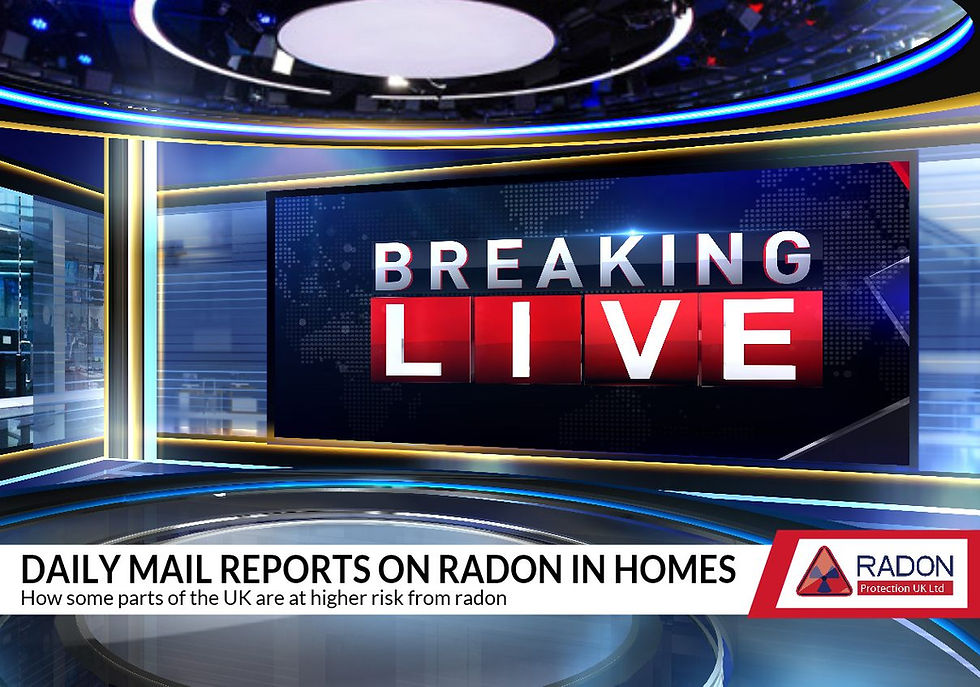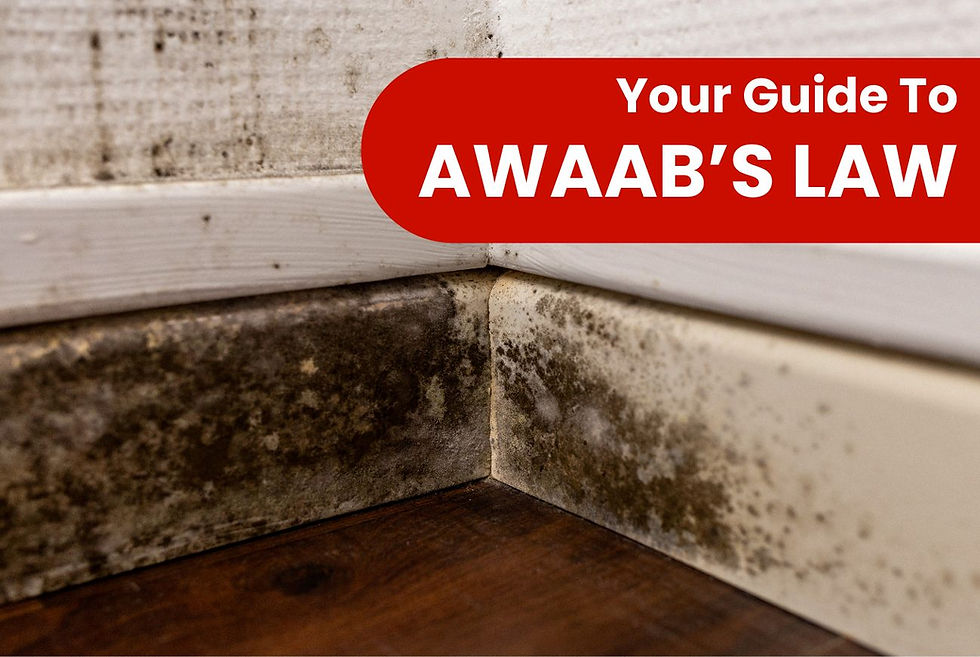How to Test Your Home for Radon: A Step-by-Step Guide
- Radon Protection UK

- Nov 3
- 8 min read
Updated: Nov 14
Radon is a naturally occurring radioactive gas that forms from the decay of uranium in rocks and soil throughout the UK. This colourless, odourless gas can accumulate in homes and buildings, potentially increasing the risk of lung cancer with prolonged exposure. Radon exposure is the leading cause of lung cancer among non-smokers and the second leading cause overall, contributing to approximately 1,100 lung cancer deaths annually in the UK. Testing your home for radon is a simple, inexpensive process that provides vital information about your family's health and safety.
Why Should You Test Your Home for Radon?
The UK Health Security Agency recommends radon testing because levels can vary dramatically between neighbouring properties, even in areas not designated as 'radon affected'. The average radon level in UK homes is 20 Bq/m³, but concentrations can range from less than 10 to over 10,000 Bq/m³. Properties are considered to be in a radon affected area when more than 1% exceed the recommended action level of 200 becquerels per cubic metre (200 Bq/m³).
Testing provides the only definitive way to determine your actual radon exposure levels. Even homes built with radon protective measures should be tested, as the UK Health Security Agency recommends testing your new home during the first year of occupation. The UK Radon Association advises that all properties should be tested for radon, regardless of whether they are located in lower, intermediate, or higher risk areas.
How Do You Know if Your Home Needs Radon Testing?

All UK homes can benefit from radon testing, but certain properties have higher risk factors that make testing particularly important. Properties with basements or cellars are especially susceptible to elevated radon levels due to their increased ground contact and often limited ventilation. The basement typically has the highest radon concentration in a building, with significantly higher probability of exceeding regulatory thresholds compared to ground floor rooms.
Properties that have undergone energy efficiency improvements require special attention when considering how to test your home for radon. Double glazing, insulation, and other weatherproofing measures can reduce natural ventilation, potentially allowing radon concentrations to increase. Any structural changes, whether major extensions or minor modifications, can influence indoor radon levels and necessitate fresh testing.
The UK Health Security Agency's free UK Radon Map provides an initial risk assessment by postcode. However, this map only indicates geological probability and cannot measure actual indoor levels. Properties in higher-risk areas shown on the map should definitely be tested, but even those in lower-risk areas can have elevated radon levels.
What Equipment Do You Need to Test Your Home for Radon?
Testing for radon requires specialised equipment that can accurately measure radon concentrations over time. The most common and cost-effective option involves passive radon detectors - small plastic devices about the size of a biscuit that absorb radon over the testing period.
Long-term radon test kits using detectors require a minimum testing period of 90 days and provide the most accurate annual average estimates. These kits are suitable for both domestic and workplace radon testing and include seasonal correction factors calculated by the UK Health Security Agency.
Short-term screening test kits offer quicker results with testing periods as brief as 7-10 days. While these provide good indication of likely long-term concentrations, they are less accurate due to daily and seasonal radon variations. Short-term tests are commonly used during property transactions when time is limited.
Digital radon monitors such as the Airthings Corentium Home provide continuous real-time measurements. These portable devices offer immediate readings but are more expensive than passive detectors. Digital monitors are particularly useful for understanding radon fluctuations and monitoring mitigation system effectiveness.
All radon detectors used for official measurements should be validated by the UK Health Security Agency to ensure accuracy and reliability. Validated suppliers participate in regular performance testing and maintain proper quality systems.
How Do You Choose the Right Radon Test Kit?
Selecting appropriate test kits depends on your timeframe, property size, and accuracy requirements. For most average-sized homes, a standard kit with two detectors provides adequate coverage. One detector should be placed in the main living area and one in a regularly used bedroom.
For property transactions: Short-term 10-day test kits offer rapid results when time is crucial. Our screening tests cost approximately £45-80 and provide results within 5 working days of detectors being returned to laboratory. However, if results are marginally above or below the action level, longer-term testing may be advisable for confirmation.
For accurate assessment: Three-month test kits provide the most reliable annual average estimates due to seasonal correction factors. Our kits cost around £40-80 including laboratory analysis and are recommended for definitive radon assessment.
For larger properties: Additional detectors may be required for properties with multiple stories, extensions, or significant size. Properties with basements should include testing both above and below ground levels. Extended properties may need detectors in both original and new sections due to different floor construction and ventilation characteristics.
When ordering test kits, ensure you can begin testing immediately, as detectors have limited shelf life. Detectors must be stored in a freezer if testing cannot start within a couple of days.
Where Should You Place Radon Detectors in Your Home?
*(Diagrams show optimum placement for Radon Test Kits)
Correct detector placement is crucial for obtaining representative measurements that reflect your actual radon exposure in frequently occupied areas. The standard approach for most homes involves placing one detector in a living room and one in a bedroom, typically covering ground floor and first floor locations.
Ground floor placement: Position the detector in your main living area - the room where your family spends the most time. If you use a kitchen/diner, family room, or study more than the formal living room, place the detector in the more frequently occupied space. Remember to correctly identify the room on your paperwork when returning detectors to the laboratory.
First floor placement: Select a bedroom that is used regularly for detector placement. The master bedroom is typically the best choice as it represents the longest continuous occupancy period.
Properties with basements: Test the basement in addition to ground floor and first floor areas. Basements frequently have the highest radon concentrations due to increased ground contact and limited ventilation. If the basement extends under only part of the building, test both a ground floor room above the basement and one over solid ground, as levels can vary considerably.
Detector positioning requirements: Place detectors at least one metre from external walls and away from heat sources, draughts, and high humidity areas. Position them approximately 1-2 metres above floor level in locations where they won't be disturbed. Avoid kitchens, bathrooms, and utility rooms due to ventilation and humidity factors.
How Long Should You Test Your Home for Radon?
Test duration significantly affects accuracy when learning how to test your home for radon, as radon levels fluctuate daily and seasonally. Different testing periods serve different purposes in the assessment process, with longer tests providing more reliable annual average estimates.
Three-month testing period: This duration provides the most accurate assessment of annual average radon concentrations. The UK Health Security Agency applies seasonal correction factors to three-month measurements, making them suitable for comparison with the 200 Bq/m³ action level. Most domestic radon testing uses this timeframe as the standard approach.
Short-term screening (7-10 days): These rapid tests offer good indication of likely long-term concentrations but provide less accurate annual average estimates. Screening tests are valuable during property transactions when quick results are essential. They cost less and deliver results faster but may require follow-up longer-term testing if results are close to action levels.
Extended testing (up to 12 months): Longer testing periods can provide even more accurate annual averages but are rarely necessary for standard domestic assessment. Some detectors accommodate testing up to 365 days for research purposes or complex situations.
Seasonal considerations: Radon levels typically vary seasonally, with higher concentrations during winter months when buildings are sealed and heating systems create greater pressure differences. Testing during winter provides worst-case scenario data, while summer testing may underestimate annual averages.
The testing period begins when you remove detectors from their protective packaging and ends when you repackage them for return. Accurate start and finish dates are essential for proper laboratory analysis and seasonal correction application.
How Do You Interpret Radon Test Results?
Understanding your radon test results involves comparing measurements to UK action levels and determining appropriate next steps based on concentration levels. Results are typically provided within 1-2 weeks of laboratory receipt and include clear recommendations.
UK action and target levels: The UK Health Security Agency maintains an action level of 200 Bq/m³ for homes, above which radon reduction measures should be implemented. A target level of 100 Bq/m³ was introduced in 2010, representing the optimal health protection goal. These levels are expressed as annual average concentrations.
Results interpretation: Properties with measurements below 100 Bq/m³ are considered low risk and typically require no action other than periodic retesting. Levels between 100-200 Bq/m³ fall in the intermediate range where householders should seriously consider reducing radon levels, especially if they are current or ex-smokers. Properties at or above 200 Bq/m³ require prompt action to reduce exposure.
Seasonal corrections: Laboratory results from 3 month testing include seasonal corrections that estimate annual average concentrations. These corrections account for typical seasonal variations in radon levels across the UK. The seasonally adjusted figures provide reliable indicators of annual average levels and are appropriate for comparison with action levels.
Result accuracy: Three-month tests provide the most reliable results due to their duration and seasonal correction application. Short-term screening results should be interpreted as indicators rather than definitive measurements. If screening results are marginally above or below action levels, longer-term confirmatory testing is advisable.
What Should You Do If Your Home Has High Radon Levels?
Properties exceeding the 200 Bq/m³ action level require radon mitigation measures to protect occupants' health. Several proven reduction techniques are available, with effectiveness depending on property characteristics and radon levels.
Radon sump systems are the most effective reduction method for most properties. These systems involve installing a small fan that draws radon-laden air from beneath the building and expels it safely outside. Active sump systems typically achieve reduction factors of 2-10 times, making them highly effective for most situations. Installation usually requires minimal structural disruption and can be completed within a day.
Positive Input Ventilation (PIV) systems provide an alternative approach, particularly effective for properties with radon levels up to 500 Bq/m³. PIV systems install a fan, typically in the loft, that gently blows filtered fresh air into the property to increase internal air pressure. This approach reverses normal pressure differentials and dilutes radon concentrations while also improving overall indoor air quality.
Underfloor ventilation may be appropriate for properties with suspended timber floors. This method increases natural air circulation beneath the building to prevent radon accumulation. Combined approaches using multiple techniques can achieve greater reduction factors when single methods prove insufficient.
Professional installation is recommended for all radon mitigation systems. The UK Radon Association maintains lists of approved contractors with appropriate training and experience. Professional installation ensures proper system design, effective operation, and compliance with building regulations.
Post-mitigation testing is essential to confirm reduction effectiveness. The UK Health Security Agency recommends retesting after mitigation installation to verify that radon levels have fallen below the action level. Most suppliers offer free confirmatory testing to demonstrate system performance.
For immediate advice and professional radon testing services, contact Radon Protection UK at 0800 9788435. Our specialists provide comprehensive testing, expert interpretation of results, and professional mitigation solutions tailored to your property's specific needs.
Frequently Asked Questions
How accurate are home radon test kits?
UKHSA-validated radon test kits provide reliable results when used correctly. Three-month tests offer greater accuracy than shorter screening tests due to seasonal radon variations and correction factors.
Can I test for radon myself?
Yes, radon testing is designed as a simple DIY process. You place passive detectors in your home for the specified period, then return them to the laboratory for analysis using the prepaid return packaging.
How much does radon testing cost in the UK?
Our radon test kits typically cost between £40-80 for domestic properties, including laboratory analysis and results report.
What radon level is considered dangerous?
The UK action level is 200 Bq/m³ annual average. Properties at or above this level should implement radon reduction measures. The target level is 100 Bq/m³ for optimal health protection.
How often should I test my home for radon?
Test once initially, then retest if home modifications occur or every 5-10 years. Properties with previous high levels should retest after mitigation to confirm effectiveness.
Sources & References
https://radonassociation.co.uk/guide-to-radon/information-for-house-buyers-and-sellers/
https://radonova.co.uk/radon-testing-a-new-uk-home-five-key-steps/
https://radonassociation.co.uk/guide-to-radon/information-for-employers/
https://www.gov.uk/government/news/ukhsa-and-bgs-publish-updated-radon-map-for-great-britain
https://assets.publishing.service.gov.uk/media/5a80d123ed915d74e62309cb/PHE-CRCE-028.pdf
https://shop.bgs.ac.uk/Resources/Shop/doc/example/Product/GRS_S011.pdf
https://www.radonshop.co.uk/10-day-radon-screening-test-kit-2-detectors-12-p.asp
https://properteco.co.uk/radon-action-levels-what-you-need-to-know/
https://www.livewest.co.uk/sites/default/files/2024-04/Radon%20Safety%20Standard%20April%202024.pdf
https://www.radonshop.co.uk/3-month-radon-test-kit-2-detectors-11-p.asp
https://ukhsa.blog.gov.uk/2015/03/20/five-facts-every-home-owner-should-know-about-radon/
https://properteco.co.uk/radon-reduction/positive-input-ventilation/
https://ukradoninfo.co.uk/radon-remediation/active-radon-remediation/active-positive-pressure-fans/
https://www.ukradon.org/cms/assets/gfx/content/resource_2722cs33267e5dc5.pdf
https://www.ukradon.org/cms/assets/gfx/content/resource_2726csb1c00bcd4b.pdf
https://www.ukradon.org/cms/assets/gfx/content/resource_2755cs17693c91d9.pdf
https://www.ukradon.org/cms/assets/gfx/content/resource_4059cs75806e8a1c.pdf
https://www.gov.uk/government/publications/uk-national-radon-action-plan
#radontestUK #radonawareness #radongasUK #homesafetyUK #radondetector #radonmitigation #RadonProtectionUK #radonlevels #homehealthUK #radontesting #UKHSAradon #lungcancerprevention #radonactionlevel #homeowneradvice #propertysafety #indoorairquality #radonspecialist #healthandhousing #radonreduction #househealthcheck










Comments